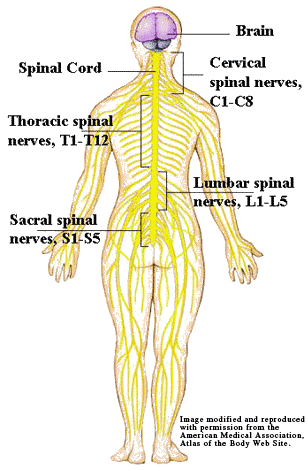Spinal Cord Injury 101
WHAT IS SPINAL CORD INJURY?

Spinal cord injury (SCI) occurs when the spinal cord becomes damaged, most commonly, when motor vehicle accidents, falls, acts of violence, and sporting accidents fracture vertebrae and crush or transect the spinal cord.
Vertebrae are the rings of bones that surround the spinal cord and make up the spinal column (back bone). The vertebrae are named according to their location in the spinal column. There are seven cervical (neck), twelve thoracic (back), five lumbar and five sacral (lower back) vertebrae.
Cervical spinal cord injuries usually cause loss of function in both the arms and legs, resulting in tetraplegia.
Thoracic spinal cord injuries usually affect the chest and the legs; and lumbar and sacral injuries affect the hips and legs, resulting in paraplegia.
The nervous system is divided into two major systems:
- The central nervous system (CNS) consists of the brain and the spinal cord.
- The peripheral nervous system (PNS) is made up of all the other nerves that carry information to and from the muscles, organs and tissues of the body.
The spinal cord connects the brain to the PNS.
Damage to the spinal cord usually results in impairments or loss of:
Movement/Muscle Control
Inability to move muscles
Muscles may have spastic contractions or may atrophy from disuse
Sensation
Inability to feel hot/cold, pressure, pain, position sense
Inability to regulate body temperature
Organ System control
Loss of control of bowel/bladder
May need treatment to assist with SCI-related pain, sexual function and fertility
For further information about spinal cord injury and the components of the nervous system, see:
Spinal Cord Injury: Hope Through Research – National Institute of Neurological Disorders and Stroke
The Life and Death of a Neuron – National Institute of Neurological Disorders and Stroke
Spinal Cord Injuries – MedLine Plus Health Information
Spinal Cord Disorders – Merck Manual Home Edition
Spinal Cord Injury Statistics
